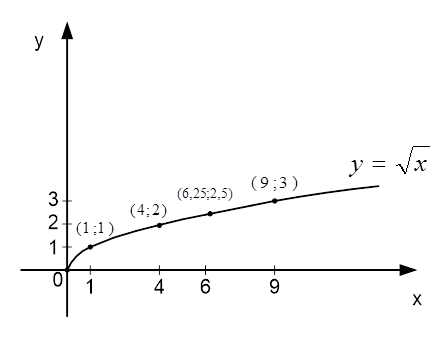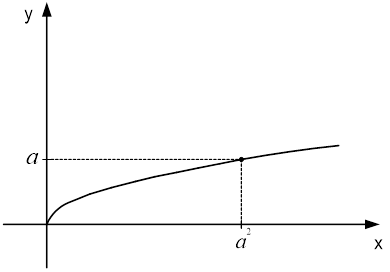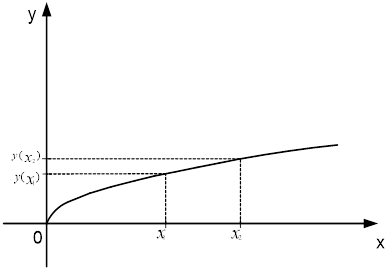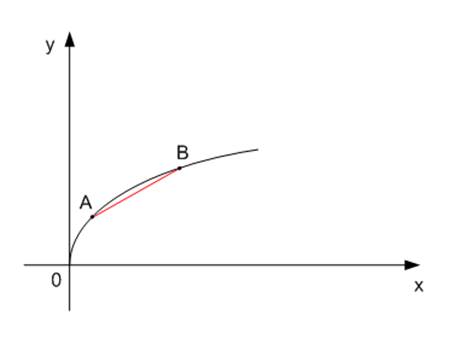Repetition, Square Root
The square root of a non-negative number ![]() is a non-negative number whose square is equal to
is a non-negative number whose square is equal to ![]() . This number is denoted by
. This number is denoted by ![]() ; the number
; the number ![]() is called the sub-root.
is called the sub-root.
![]()
Examples:
1. ![]() (
(![]() ,
, ![]() )
)
2. ![]() (
(![]() ,
, ![]() )
)
Note:
![]() , but
, but ![]() – the root cannot be equal to a negative number.
– the root cannot be equal to a negative number.
![]() – cannot be calculated. The square root of a negative number does not exist.
– cannot be calculated. The square root of a negative number does not exist.
Function 
A function ![]() , where
, where ![]() , is a law that maps a number
, is a law that maps a number ![]() to each non-negative number
to each non-negative number ![]() .
.
![]()
We already know the function ![]() . It is a function of type
. It is a function of type ![]() . So we will study the function
. So we will study the function ![]() on the basis of the function
on the basis of the function ![]() where
where ![]() .
.
The graph of a function 
The graph of function ![]() is a branch of a parabola. Let us check this by making a table.
is a branch of a parabola. Let us check this by making a table.
|
x |
0 |
1 |
4 |
6.25 |
9 |
|
|
0 |
1 |
2 |
2.5 |
3 |
Draw the found points on the coordinate plane (see Fig. 1).

Fig. 1. The graph of the function ![]()
Let's read the graph:
If the argument increases from 0 to ![]() , the function increases from 0 to
, the function increases from 0 to ![]() .
.
Properties of the function 
1. The set of values of the function ![]() is ray
is ray ![]() .
.
Let us prove this property
The proof is
Let ![]() be an arbitrary number from the interval
be an arbitrary number from the interval ![]() . Can we find a number
. Can we find a number ![]() such that
such that ![]() ? To find it, solve the equation:
? To find it, solve the equation:
![]()
![]()
The number ![]() is reached when the argument is equal to
is reached when the argument is equal to ![]() (see Figure 2).
(see Figure 2).

Figure 2. Illustration of the proof
Hence:
![]()
This was required to prove it.
Consequences of this property
a) The function ![]() is not bounded from above. That is, there is no largest positive number on the Y axis for this function.
is not bounded from above. That is, there is no largest positive number on the Y axis for this function.
b) The function is bounded from below and has the smallest value.
c) ![]() for all
for all ![]() .
.
2. The function ![]() increases monotonically over the entire range of determination, that is, at
increases monotonically over the entire range of determination, that is, at ![]() .
.
![]() Note:
Note:
A function is called monotonically increasing over the entire domain of determination if, for any ![]() and
and ![]() belonging to the domain of determination, the inequality
belonging to the domain of determination, the inequality ![]() follows from the inequality
follows from the inequality ![]() .
.
Figure 3 illustrates to us that the function ![]() is monotonically increasing.
is monotonically increasing.

Fig. 3. Function ![]() is monotonically increasing
is monotonically increasing
3. The function ![]() is convex upwards on the entire domain of definition.
is convex upwards on the entire domain of definition.
For any two points, such as ![]() and
and ![]() (see Figure 4), the arc lying between these points will be over the segment connecting these two points, hence the function is convex upwards.
(see Figure 4), the arc lying between these points will be over the segment connecting these two points, hence the function is convex upwards.

Figure 4. Function ![]() convex upwards
convex upwards
2. If you find an error or inaccuracy, please describe it.
3. Positive feedback is welcome.